
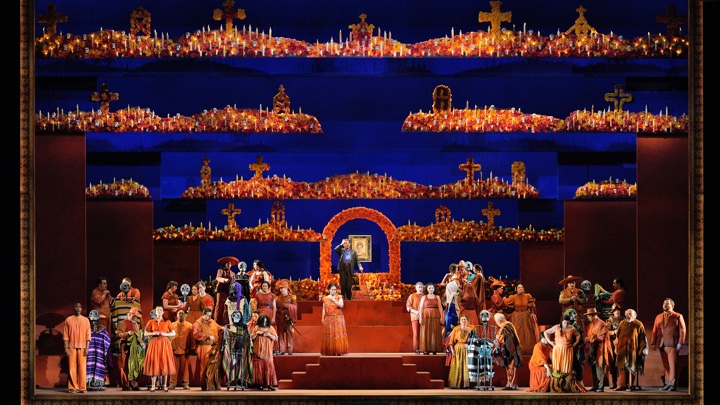
A co-production with San Diego Opera (and co-commissioned by Fort Worth Opera and DePauw University School of Music with support from The University of Texas at Austin College of Fine Arts), Frida y Diego was first heard at San Diego Civic Theatre on October 29, 2022. For San Francisco Opera, Frida y Diego marked an important milestone, as it is the first Spanish-language opera to be performed by the Company, and more importantly, it is the first commission from a female composer to be performed on the mainstage in its 100-year history.
A 15-year work in the making, this was supposed to be Frank and Cruz’s first piece together, but instead thirteen other projects appeared before the premiere of Frida y Diego, including the ambitious 2017 Conquest Requiem, their commentary on the Spanish conquest of the Aztec Empire that is scheduled to make an appearance at the Metropolitan Opera (as is this opera.) During that period the Cuban-American Cruz, a Pulitzer Prize-winner for 2003 Anna in the Tropics, also served as librettist for Peruvian composer Jimmy López’s Bel Canto, which premiered in Chicago in December 2015.
In the animated pre-concert talk by Jessica Bejarano, SF Opera’s Curator and Scholar in Residence, she repeatedly stressed that the opera was not a biography but more a reimagined fiction (hence the word “dream” in the title). The premise of the story was pretty straigh-forward; it was the Día de los Muertos (where the departed could return to the living world for 24 hours) and Diego wished to see his Frida one last time.
Initially she refuses (due to Diego’s treatment and her spinal injury while living), but she relented as she wanted to revisit her arts. In the end, Frida led Diego to the Underworld together with her to be united in eternity (Factoid: The Day of the Dead fell on November 2, 1957, while the real Diego passed away three weeks later).
Much has been said about the nature of the story which seemed to suggest the reversal of Orpheus and Eurydice legend. Personally, I drew a more direct parallel between the opera and Pixar Studios’ 2017 feature Coco (one of my most favorite Pixar movies ever); not only both stories revolved around the Day of the Dead and the 24-hour return to the living world, but particularly both also explored the center theme around creation and preservation of Arts (music for Coco, and paintings for Frida y Diego).
Frank’s score for Frida y Diego was nothing short of extraordinary, at times recalling Béla Bartók (in her treatment for climaxes) or Giacomo Puccini (in her handling of choruses), but the musical idioms were certainly her own. I particularly mesmerized by many instrumental solos peppered throughout the score (most particularly the bassoon and violin solos), and Frank used such device to define the characters, almost in a way of leitmotif.
There was nothing remotely “Mexican” in the writing (except probably the mariachi-like trumpet sections in Act 1), perhaps done intentionally to emphasis the dreamlike aspect of the opera. She, however, was a master (or more appropriately, mistress) in moving the actions forward in big climaxes, and her choral writings were exemplary. In her hands, the chorus didn’t only serve as a Greek chorus (to comment on the actions), but also became an integral part of the score, providing specific nuances and colors to each scene.
Unlike Frank’s score, the creative team led by the Mexican stage director Lorena Maza, brought the production closer to Mexican traditions and yes, both Frida and Diego’s body of arts, even if she insisted in her program notes that
Our challenge in this production was to create a unique universe that conveys the main symbols, gestures, and imagery of their iconography and their lives, in a very symbolic and depurated style, avoiding textual reproductions and the usual interpretation of Mexican folklore cliché or massive media exploitation of Frida’s and Diego’s life and image. We wanted to create our own vision of this particular and beautiful story.
The end result is a production that was truly enchanting yet puzzling at times, as described in detail below.
Act 1 was, for lack of a better word, simply flawless. When the curtain opened, Jorge Ballina’s sets were truly a sight to behold—setting the cemetery scene as terraced offerings of flowers and candles, with the altar for Frida right on top and center. Ballina showered the stage with shades of orange (and red), and as illuminated by Victor Zapatero’s soft lighting, it gave a somber expression to the whole thing.
Upon this grave, baritone Alfredo Daza (who also originated the role in San Diego) made an appearance as the weak and dying Diego, visiting Frida’s altar. Daza acted well as the sickly Diego, however on Tuesday his voice was often drowned by the force of the orchestra, conducted by Roberto Kalb.
A short encounter with three villagers followed (voiced by John Fulton, Ricardo Lugo, and an impressive Adler fellow Moisés Salazar), and afterwards Diego called out for Frida to return to him. From then on, Diego, particularly as characterized by Daza, desperately seeking Frida to return to him, almost to the point of obsession. Just before the end of the scene, Diego was approached by an old woman, who turned out to be La Catrina, Keeper of the Dead.
Debuting Chilean soprano Yaritza Véliz truly made a scene-stealing role as La Catrina. Frank wrote a high-flying tessitura for the role, and Véliz executed it with a sense of ease and almost playfulness. Her Catrina was often times scary, sarcastic and even funny, and she had no problems riding over the thick sounds of both the orchestra and chorus. She seemed unfazed by the heavy skeletal costumes and make-up by Eloise Kazan (inspired by one of Diego’s paintings); it was a truly tour de force performance by Véliz!
The transition for the Underworld next scene was handled effectively and beautifully by Ballina, with the aforementioned flowers and candles offerings simply moved upwards, leaving the orange terraced platforms became the Underworld. Upon those platforms, Kazan dressed the Chorus in various shades of oranges as the denizens of that world. Orange seemed to be the designated color for Frida, as that was the color of her costumes while in the Underworld. I particularly loved the efficiency in Kazan’s costuming by showing those that were going back to the living world changed their orange-ish costume to a colorful one!
As Frida, Argentinian mezzo-soprano Daniela Mack embodies the role with heart and soul, presenting a wholesome take on the strong-willed and stubborn Frida. While occasionally Mack, too, was drowned by the orchestra (especially in the beginning), eventually she conjured a strong presence with her full and round voice, particularly for the heartbreaking “Agony” scene, where she was remembering her physical pain back in the living world.
That scene was even made memorable by the Maza’s direction, where four dancers pulled red ribbons from Frida’s waist to different directions, keeping Frida in a bondage position. Musically, that “Agony” declamations proved to be one of Frank’s highlights, as it showcased how much the character Frida meant for Frank (Just like Frida’s polio, Frank was born with significant hearing loss!)
The fourth principal of the opera, and the catalyst for Frida to come back to the living world, was the cross-dressing Greta Garbo impersonator Leonardo, sang sensitively by debuting countertenor Jake Ingbar in a costume that (to me anyway) recalling Norma Desmond’s from Sunset Boulevard (I’m not familiar with Garbo’s body of work, so please do let me know if the photo below resembling one of her movies!)
While the character Leonardo felt rather random in the opera, Ingbar pulled all stops in his personification, both in his weighty and opulent voice that he produced, and in his serious mannerisms to personify Garbo without making her a caricature. The character also might have been a special for Frank and Cruz, as Frank concocted shimmering, delicate melodies for each of Leonardo’s scenes, oftentimes with celeste and piano.
The role proved to delight the audience significantly, and on Tuesday, Ingbar received one of the loudest cheers! Leonardo persuaded Frida to come back to the living world for her colors, for her arts (just as he wanted to come back to comfort a Garbo’s grieving fan) and that act successfully brought Act 1 to a rousing ending, after La Catrina warned Frida that she had only 24 hours, and that she couldn’t embrace the living (Fun fact: by 1957, Garbo hadn’t died yet … she lived until 1990!)
Act 2 proved to be much more complicated in terms of both dramaturgy and staging. In the beginning, the living world was represented by blue panels (no doubt representing Casa Azul, where both Diego and Frida used to live) with white canvas, upon which Diego was seen to be trying to paint.
Nevertheless, he was unable to paint, and Frida showed up in the canvas, and in a spectacular turn of event, the denizens of the underworld turned up into the characters of Diego’s famous mural, Sueño de una tarde dominical en la Alameda Central (Dream of a Sunday Afternoon at Alameda Central Park). Personally, while I understood the motivation for this major “downgrade” from the extravagant set for Act 1, it was hard not to think that the creative team might think that the living world was a world of pain or suffering!
The following scene brought the couple back to Casa Azul, and when Frida tried to paint, alas, she couldn’t because she felt no pain anymore. She eventually decided to embrace Diego, and by doing so, inviting all her living pain, and, what seemed to be the opera’s pièce de resistance, conjuring her famous images of herself on stage (completed with her three famous portraits sang by Mikayla Sanger, Nikola Printz and Gabrielle Beteag accordingly.) That scene was painfully beautiful, particularly with Kazan’s detailed recreation of Frida’s famous paintings and Ballina’s delightful framings for the portraits!
Unfortunately, the final part of Act 2 turned out to be the Achilles’ heel of the opera, both in terms of the dramaturgy and the staging, as Frida (and in the lesser term, Diego) decided to abandon her identity and to conform with the opera norms (in the words of Diego: “Since when you follow the rules, Frida?”), ending the opera as mushy lovey-dovey star-crossed lovers a la La bohème as she led him into the Underworld. Personally, I would rather see that both of them led each other to the Underworld in order to paint, to create Arts, to inspire each other and to become each other’s muse, from here to eternity!
As mentioned before, Kalb led the San Francisco Opera Orchestra in a way that moved the story nicely, even though he drowned the singers at times. I had to single out the SF Opera Chorus, led by John Keene, that truly realized Frank’s score with a glorious sparkle, becoming an active participant in the whole drama!
In the end, I truly applauded San Francisco Opera for opening doors for this historic production, and I couldn’t wait to see what they had in store. Welcome to the bright future of the second Century of the San Francisco Opera, indeed!
Photos: Cory Weaver/San Francisco Opera














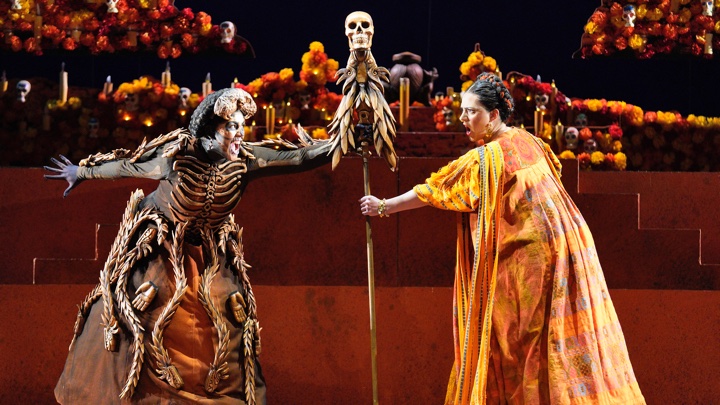
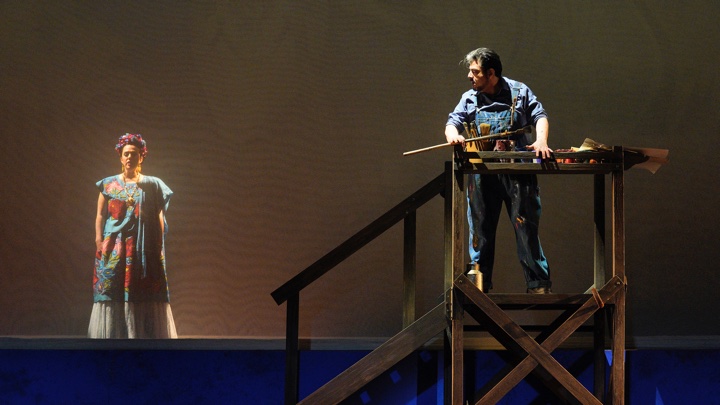
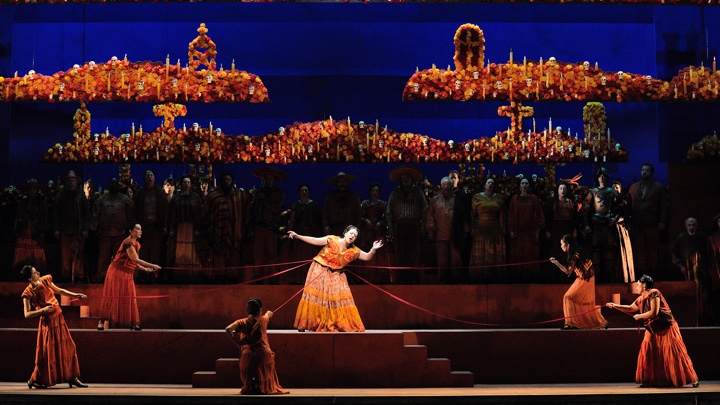
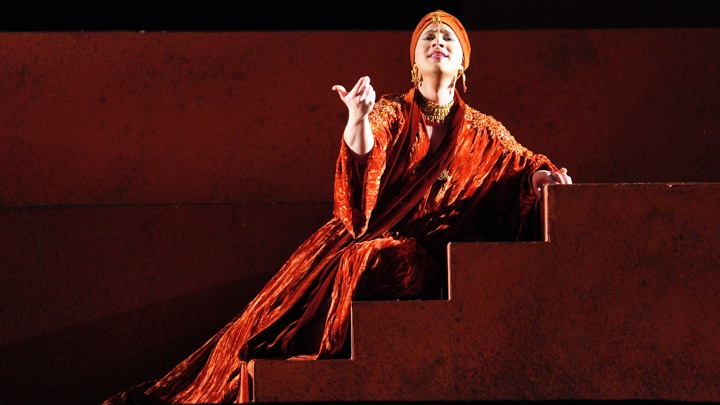
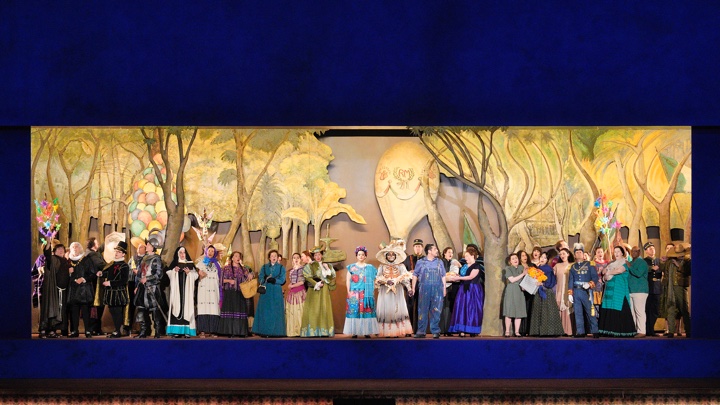
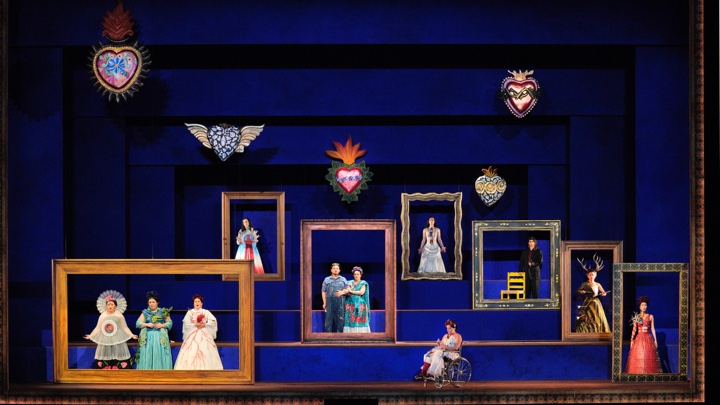











Comments